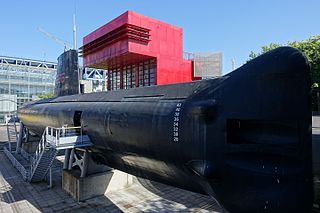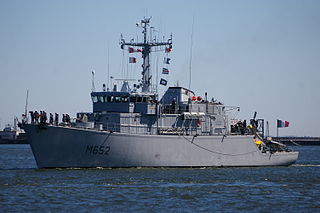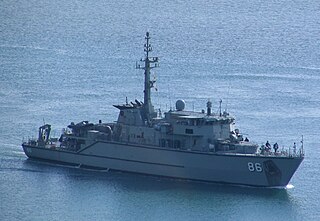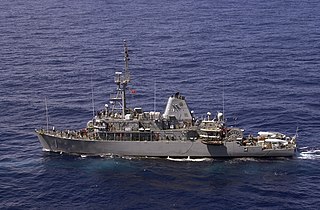
The Double Eagle is a remotely operated vehicle (ROV) built by the Swedish defence company Saab Underwater Systems AB and used for the disposal of naval mines. [1]

The Double Eagle is a remotely operated vehicle (ROV) built by the Swedish defence company Saab Underwater Systems AB and used for the disposal of naval mines. [1]
As of 2009, four versions of the ROV have been designed. [1] [2]
The original version was named the Sea Eagle, and was a militarised variant of the civilian Sea Owl ROV. [1] This unit was 1.3 metres (4 ft 3 in) long, 0.76 metres (2 ft 6 in) wide, and 0.4 metres (1 ft 4 in) high, could travel at 3 knots (5.6 km/h; 3.5 mph), and dive to 500 metres (1,600 ft). [1] These ROVs saw service with the Swedish Navy from 1984 onwards. [1]
The second version, named the Double Eagle, is larger, measuring 1.9 metres (6 ft 3 in) in length, 1.3 metres (4 ft 3 in) in width, and 0.8 metres (2 ft 7 in) in height. [1] The ROV weighs 400 kilograms (880 lb), can dive to 500 metres (1,600 ft), and travel at 5 knots (9.3 km/h; 5.8 mph). [1]
The Double Eagle Mark II is larger but lighter than the first Double Eagle. [1] Measuring 2.1 metres (6 ft 11 in) long, 1.3 metres (4 ft 3 in) wide, and 0.5 metres (1 ft 8 in) high, the unit weighs 340 kilograms (750 lb), dives to 500 metres (1,600 ft), and can reach 6 knots (11 km/h; 6.9 mph). [1] The Mark II entered service in 1994. [2]
The Mark III is 80 centimetres (31 in) longer and 130 kilograms (290 lb) heavier than its predecessor. [2]
The ROV's payload can consist of scanning sonar, echo locations, doppler logs, or self-navigation systems. [2] All Double Eagles are equipped with an extendable manipulator arm, which is commonly used to place a small explosive charge on a mine. [1] The ROV can be modified to double as a self-propelled variable depth sonar: the Mark II Double Eagles fitted to the French Navy's Tripartite-classminehunters have been altered to carry a Thales TSM 2022 sonar, while a similar upgrade is to occur to the Mark III units being acquired for the Tripartites of the Royal Netherlands Navy. [2]
The Double Eagle Mark II uses two 5 kilowatt brushless electric motors for main propulsion, and six 0.4 kilowatt brushless electric motors for fine manoeuvering. [3] Mark III ROVs have four 7 kilowatt brushless electric motors as main thrusters.[ citation needed ] Double Eagles can operate in any orientation. [1]

A remotely operated underwater vehicle is a tethered underwater mobile device, commonly called underwater robot.

A minehunter is a naval vessel that seeks, detects, and destroys individual naval mines. Minesweepers, on the other hand, clear mined areas as a whole, without prior detection of mines. A vessel that combines both of these roles is known as a mine countermeasures vessel (MCMV).

The Flyvefisken-class patrol vessels are warships of the Royal Danish Navy. The class is also known as the Standard Flex 300 or SF300 class. The five vessels sold to the Portuguese Navy are locally referred as Tejo class.

The Kingston class consists of 12 coastal defence vessels operated by the Royal Canadian Navy. The class is the name for the Maritime Coastal Defence Vessel Project (MCDV). These multi-role vessels were built and launched from the mid- to late-1990s and are crewed by a combination of Naval Reserve and Regular Force personnel. The main mission of the vessels is to train reservists, coastal patrol, minesweeping, law enforcement, pollution surveillance and search and rescue duties. The multi-purpose nature of the vessels led to their mixed construction between commercial and naval standards. The Kingston class is split between the east and west coasts of Canada and regularly deploy overseas to West Africa, Europe, Central America and the Caribbean.

The Huon-class minehunter coastal (MHC) ships are a group of minehunters built for the Royal Australian Navy (RAN). Following problems with the Bay-class minehunters, a request for tender was issued in 1993 for a class of six coastal minehunters under the project designation SEA 1555. The tender was awarded in 1994 to the partnership of Australian Defence Industries (ADI) and Intermarine SpA, which was offering a variant of the Italian Gaeta-class minehunter.

HMAS Huon, named for the Huon River, is the lead ship of the Huon class of minehunters operated by the Royal Australian Navy (RAN). The first of six ships built by a joint partnership of Australian Defence Industries (ADI) and Intermarine SpA, Huon's hull was fabricated at Intermarine's Italian shipyard, then freighted to ADI facilities at Newcastle for completion. She entered service in 1999.

Argonaute is an Aréthuse-class submarine, and the fourth ship of the French Navy to bear the name. Launched on 29 June 1957, the submarine served as flagship within the Toulon submarine squadron. Argonaute was decommissioned on 31 July 1982. The vessel was converted to a museum ship in 1989 and located in Paris.

The Tripartite class is a class of minehunters developed from an agreement between the navies of Belgium, France and the Netherlands. A total of 35 ships were constructed for the three navies. The class was constructed in the 1980s–1990s in all three countries, using a mix of minehunting, electrical and propulsion systems from the three member nations. In France, where they are known as the Éridan class they are primarily used as minehunters, but have been used for minesweeping and ammunition transport in Belgium and the Netherlands, where the Tripartites are known as the Alkmaar class.

The Aréthuse class were submarines built for the French Navy in the 1950s. They were designed as attack submarines for anti-submarine warfare and were referred to as Sous-marins de Chasse by the French Navy. These submarines had advanced sensors and were very quiet. They were influenced by the World War II German Type XXIII U-boats. The Daphné class are an enlarged version built for the French, Pakistani, Portuguese, Spanish and South African navies.

HMAS Diamantina, named after the Diamantina River, is a Huon-class minehunter currently serving in the Royal Australian Navy (RAN). Built by a joint partnership between Australian Defence Industries (ADI) and Intermarine SpA, Diamantina was constructed at ADI's Newcastle shipyard, and entered service in 2000.

HMAS Melville is the second ship of the Leeuwin class of hydrographic survey vessels operated by the Royal Australian Navy (RAN).

HMAS Norman, named for the Norman River in Queensland, is the third Huon-class minehunter to serve in the Royal Australian Navy (RAN). Built by a joint partnership between Australian Defence Industries (ADI) and Intermarine SpA, Norman was constructed at ADI's Newcastle shipyard, and entered service in 2000.

Katanpää-class mine countermeasure vessels are a class of three multipurpose mine countermeasure vessels (MCMV) ordered by the Finnish Navy. The nearly 250 million euro contract was awarded to the Italian shipyard Intermarine S.p.A. in 2006. Initially, all three vessels were scheduled to be delivered by 2014 and the class was expected to achieve operational readiness by 2015, but there have been various delays and the last vessel was handed over to the Finnish Navy in November 2016.

HMAS Gascoyne, named for the Gascoyne River, is the fourth of six Huon-class minehunters constructed for and currently in service with the Royal Australian Navy (RAN). Built by a joint partnership between Australian Defence Industries (ADI) and Intermarine SpA, Gascoyne was constructed at ADI's Newcastle shipyard, and entered service in 2000.

HMAS Hawkesbury, named for the Hawkesbury River, is the second Huon-class minehunter to have been built for the Royal Australian Navy (RAN). Built by a joint partnership between Australian Defence Industries (ADI) and Intermarine SpA, Hawkesbury was constructed at ADI's Newcastle shipyard, and entered service in 2000.

HMAS Yarra is the sixth Huon-class minehunter to have been built for the Royal Australian Navy (RAN) and the fourth warship to be named after the Yarra River in Victoria. Built by a joint partnership between Australian Defence Industries (ADI) and Intermarine SpA, Yarra was constructed at ADI's Newcastle shipyard, and entered service in 2003.

The Paluma-class motor launch is a class of four hydrographic survey motor launches operated by the Royal Australian Navy (RAN). Built in Port Adelaide between 1988 and 1990, the four catamarans are primarily based at HMAS Cairns in Cairns, Queensland, and operate in pairs to survey the waters of northern Australia.

Avenger-class mine countermeasures ships are a class of 14 ships constructed for the United States Navy from 1987 to 1994, designed to clear mines from vital waterways. The ships have the hull designator MCM.

The Lerici class is a class of minehunters constructed by Intermarine SpA and owned and operated by the Italian Navy. The class incorporates two subclasses: the first four ships are referred to specifically as the first series of the Lerici class, while eight more ships produced to a slightly modified design are known as "second series Lericis" or as the Gaeta class.

The Arafura class is a class of offshore patrol vessels being built for the Royal Australian Navy (RAN). Initially proposed in the 2009 Defence White Paper and marked as procurement project SEA 1180, it was originally planned that 20 Offshore Combatant Vessels (OCV) would replace 26 vessels across four separate ship classes: the Armidale-class patrol boats, the Huon-class minehunters, the Leeuwin-class survey vessels, and the Paluma-class survey motor launches. Although having a common design, the ships would use a modular mission payload system to fulfill specific roles; primarily border patrol, mine warfare, and hydrographic survey. The 2013 Defence White Paper committed to the OCV project as a long-term goal, but opted in the short term for an accelerated procurement of an existing design to replace the Armidales, and life-extension refits for the other types. This resulted in the Offshore Patrol Vessel (OPV) project and the amount of vessels reduced to 12. However, this was further increased to 14 when 2 further Mine Counter Measures variants were proposed under SEA 1905.
| Wikimedia Commons has media related to Double Eagle (ROV) . |